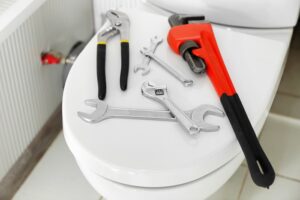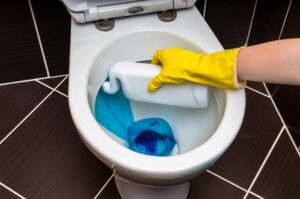Whether we would like to admit it or not as homeowners, the toilets in our residence are one of the most used appliances when compared to others in the home. Because a toilet is used on a regular basis, it is important to regularly keep up with maintenance and cleaning to ensure that the toilet is always in working order.
Maintenance and cleaning is important because it can add years of use out of a toilet without needing to have them repaired or replaced. In some instances, we are talking about a time frame of about five extra years, depending on specific circumstances of the home and its use.
Apart from understanding that toilets need to be well maintained, it is also important for homeowners to understand some of the issues which can cause additional wear and tear apart from regular use.
If you are a homeowner who is interested in getting the most out of their toilet, and adding years of use to the appliance without the need of costly repairs and replacement, we will be going over some of the actions that can be taken which can help out immensely.
How Homeowners Should Go About Regular Toilet Cleaning
If you are someone who is serious about making sure that your toilet is in the best shape in order to add years to its longevity and use, a good place to start is getting into a good cleaning routine.
Not only does cleaning a toilet make it much nicer to use and interact with, but it can also ensure that the internal components are in the best possible shape, implying that they will be less likely to break due to stress and wear.
Most people are aware that cleaning is important to maintaining a proper toilet or any other appliance, but not everyone knows how they should go about doing so. The first thing that homeowners should do in preparation for regular toilet cleaning is to ensure that they have all the necessary cleaning products and tools to be effective.
Supplies and Materials Needed:
Some of these supplies are optional, however, the optional materials are going to make cleaning easier and more comfortable for the person who is doing it.
To begin with, the most important cleaning products to have for cleaning a toilet thoroughly are Toilet Bowl Cleaner and Disinfectant Wipes. These items will help remove any buildup of dirt and grime, but it can also eliminate other issues such as smells and stains which may not affect the function of a toilet, but definitely makes it look gross.
Another important tool that is needed to clean the inside of the toilet bowl effectively is a Toilet Wand/Scrubber. A homeowner should not be cleaning the inside of their toilet bowl by hand because it is not only gross but can also be ineffective to reach those harder areas like under the rim.
Although it is not recommended to clean without this, most individuals will suggest that you clean the toilet with a set of Rubber Gloves. This makes it more hygienic and makes people more comfortable cleaning a dirty toilet.
Steps Homeowners Should Take to Cleaning a Toilet:
Now that an individual has all the supplies needed to clean a toilet effectively from the inside out, here are some general steps that a person should follow which can make their toilet last for many more years without needing to be repaired or replaced.
- Put on Gloves (Optional): If you are someone who would prefer to use rubber gloves, put them on now in order to protect your hands during the cleaning process.
- Flush the Toilet: Start by flushing the toilet to clear the bowl of any loose debris or water. A homeowner should never take it upon themselves to clean the inside of the toilet without removing any debris or byproducts.
- Apply Toilet Bowl Cleaner:
-
- Squirt or pour the toilet bowl cleaner into the bowl, making sure to cover the entire surface, including under the rim. Make sure to always follow the direction found on the product you are using as a cleaner, as different products may need to be applied differently.
- If you prefer a more natural cleaning solution, you can mix equal parts white vinegar and water, or use a paste made from baking soda and water. Apply these alternatives in the same manner as commercial toilet bowl cleaners.
- Scrub the Bowl: Use a toilet brush to scrub the inside of the toilet bowl thoroughly. Pay attention to areas with stains, mineral deposits, or discoloration. Scrub under the rim as well. This is the part that homeowners do not want to use little effort on, as it is the most important part of the cleaning process. This is something that should take a few minutes, and not only be done with one or two scrubs.
- Clean the Exterior: Once you have cleaned the inside of the bowl, now it is time to move to the outside areas of the toilet.
- Wipe down the exterior of the toilet tank and bowl with disinfectant wipes or a damp cloth. Be sure to clean the handle, seat, and hinges. You will especially want to focus on the bottom areas of the toilet, and the hard-to-reach areas behind the toilet and tank.
- For stubborn stains on the exterior porcelain, you can use a bathroom-specific cleaner or a mixture of baking soda and water. Apply the paste or cleaner, let it sit for a few minutes, and then scrub gently.
- Clean the Seat and Lid: Lift the seat and lid, if applicable, and clean both sides with disinfectant wipes or a damp cloth. While we might think these areas are covered, they can still accumulate a lot of grime and build up.
- Clean the Flush Handle: Use a disinfectant wipe or a cloth dampened with a disinfecting solution to clean the flush handle thoroughly.
- Rinse and Flush: After cleaning, flush the toilet again to rinse away any remaining cleaning solution and debris. While it’s important to have cleaners set for a few minutes, it is not the best to have them sit in the bowl or on the surface of the toilet all day.
- Dry and Polish: Use a dry cloth or paper towel to dry and polish the exterior of the toilet, including the tank and seat.
- Dispose of Cleaning Materials: Properly dispose of any used cleaning materials and gloves, if you wore them.
- Wash Your Hands: After completing the cleaning process, thoroughly wash your hands with soap and water to ensure hygiene. You do not want to contaminate other areas of the home or get yourself sick because you were not being careful.
Cleaning Frequency:
To maintain a clean and hygienic toilet, clean it at least once a week, but this number will depend on how often the toilet is being used in a home. If your toilet sees heavy use, you may need to clean it more frequently. Additionally, perform a deep cleaning, including under the rim and inside the trap, on a monthly or quarterly basis to prevent mineral buildup and stains.
Regular cleaning not only keeps your toilet looking and smelling fresh, but also helps prevent the buildup of bacteria and mineral deposits, which can extend the lifespan of your toilet and reduce the need for repairs.
 Making Sure all Toilet Parts are In Working Order
Making Sure all Toilet Parts are In Working Order
If you want your toilet to last for many years to come, it is important to occasionally check all the working parts of the toilet to ensure that there are no issues. When this is done, it puts less strain on the different moving parts that make a toilet functional.
Checking if all parts of the toilet are in working order is a crucial part of toilet maintenance. Here’s a step-by-step guide on how homeowners can perform a basic inspection to ensure that their toilet is functioning correctly.
Steps to Check Toilet Parts for Working Order:
- Inspect the Flush Mechanism:
-
- Flush the toilet to ensure that the flush lever (the handle) is working correctly. It should lift the flapper or flush valve in the tank and allow water to flow into the bowl.
- Check that the flush lever returns to its original position after flushing. If it doesn’t, it may need adjustment or replacement.
- Check for Leaks:
-
- After flushing, listen for any unusual hissing or running water sounds. These noises can indicate a leak in the tank or bowl.
- Visually inspect the area around the base of the toilet for water or moisture. If you notice any, it could indicate a leaking wax ring or a faulty seal.
- Examine the Flapper or Flush Valve:
- Lift the tank lid and inspect the flapper or flush valve. It should be in good condition, without any cracks or visible damage. Ensure it seats properly over the drain hole when not in use.
- Check for any water stains or discoloration around the flapper or flush valve. This could indicate a slow leak.
- Inspect the Fill Valve:
-
- The fill valve (also known as the ballcock) controls the water level in the tank. Check for any signs of water leaking from the fill valve.
- Ensure the fill valve is not making unusual noises, such as a constant hissing or sputtering, which may indicate a problem.
- Check Water Supply Connection:
-
- Examine the water supply line that connects to the toilet tank. Make sure there are no visible leaks or drips at the connection points.
- Turn the shut-off valve off and then back on to ensure it operates smoothly. It should completely stop the flow of water when turned off.
- Inspect the Toilet Bowl:
-
- Examine the toilet bowl for any visible cracks, chips, or damage. Inspect the inside surface for stains or mineral deposits.
- Ensure that the toilet bowl is securely attached to the floor. Check for any wobbling or movement.
- Test the Flush Power:
-
- Flush the toilet and observe the strength and speed of the flush. A weak flush could indicate a clog or a problem with the flush mechanism.
- Check the Toilet Seat:
-
- Ensure that the toilet seat and lid are securely attached to the bowl and that they open and close smoothly without wobbling.
- Look for Rust or Corrosion:
-
- Examine the tank and bowl for any signs of rust or corrosion, especially around bolts and connections.
- Use a Flashlight (Optional):
-
- If you have a hard time seeing all areas, especially in tight spaces, use a flashlight to get a better view of the toilet components.
If you notice any issues during this inspection, such as leaks, unusual noises, or visible damage, consider addressing them promptly to prevent further damage or water wastage. For more complicated issues or repairs, it may be advisable to consult a professional plumber. Regular inspections can help you catch and address problems early, potentially extending the lifespan of your toilet.

